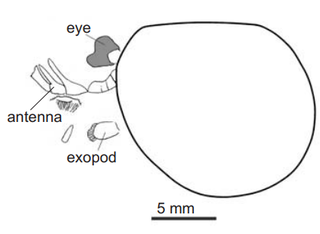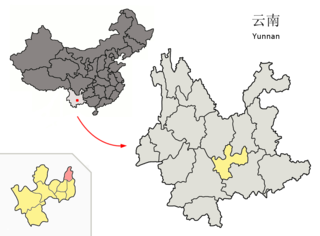
Lobopodians are members of the informal group Lobopodia, or the formally erected phylum Lobopoda Cavalier-Smith (1998). They are panarthropods with stubby legs called lobopods, a term which may also be used as a common name of this group as well. While the definition of lobopodians may differ between literatures, it usually refers to a group of soft-bodied, marine worm-like fossil panarthropods such as Aysheaia and Hallucigenia.

Opabinia regalis is an extinct, stem group arthropod found in the Middle Cambrian Burgess Shale Lagerstätte of British Columbia. Opabinia was a soft-bodied animal, measuring up to 7 cm in body length, and its segmented trunk had flaps along the sides and a fan-shaped tail. The head shows unusual features: five eyes, a mouth under the head and facing backwards, and a clawed proboscis that probably passed food to the mouth. Opabinia probably lived on the seafloor, using the proboscis to seek out small, soft food. Fewer than twenty good specimens have been described; 3 specimens of Opabinia are known from the Greater Phyllopod bed, where they constitute less than 0.1% of the community.

Leanchoilia is a megacheiran arthropod known from Cambrian deposits of the Burgess Shale in Canada and the Chengjiang biota of China.

Forfexicaris valida is a species of Lower Cambrian arthropod, the only species in the family Forfexicarididae. It is known from only two specimens from the Maotianshan shale Lagerstätte.

Parapeytoia is a genus of extinct arthropod that lived over 530 million years ago in the Maotianshan shales of prehistoric China. It was interpreted as an anomalocaridid (radiodont) with legs, but later studies reveal it was a megacheiran, a group of arthropods which are no longer thought to be closely related to the radiodonts.

Urokodia aequalis is an extinct genus of arthropod from the early Cambrian. The taxon is only known from the Maotianshan Shales of China based on some 15 specimens. Its segmentation resembles that of a millipede and it possessed head and tail shields with thorny spikes. It has some similarities to the arthropod Mollisonia that is known from both the Burgess Shale of Canada and the Kaili biota of China. Recently, the taxon has been considered a member of the order Mollisoniida, alongside Mollisonia, Thelxiope, and Corcorania, the group are suggested to be stem-chelicerates.

Helmetia is an extinct genus of arthropod from the middle Cambrian. Its fossils have been found in the Burgess Shale of Canada and the Jince Formation of the Czech Republic.

Odaraia is a genus of bivalved arthropod from the Middle Cambrian. Its fossils, which reach 15 centimetres (5.9 in) in length, have been found in the Burgess Shale in British Columbia, Canada.

Chengjiang is a city located in Yuxi, Yunnan Province, China, just north of Fuxian Lake.

Plenocaris plena is a Cambrian arthropod with a bivalved carapace, and is known from the Burgess shale and Chengjiang. Originally described as a species of Yohoia by Walcott in 1912, it was placed into its own genus in 1974.

Chuandianella ovata is an extinct bivalved arthropod that lived during Cambrian Stage 3 of the Early Cambrian. It is the only species classified under the genus Chuandianella. Its fossils were recovered from the Chengjiang Biota in Yunnan, China.

Occacaris oviformis is an extinct nektonic predatory arthropod from the Lower Cambrian Maotianshan shale Lagerstätte. It bears a superficial resemblance to the Cambrian arthropod, Canadaspis, though, was much smaller, and had a pair of "great appendages", with which it may have grasped prey. It was originally considered to belong to Megacheira, however it is questioned in later study.

Pectocaris is a extinct genus of bivalved arthropods from the Cambrian Maotianshan Shales, Yunnan Province of China. There are currently three known species within the genus.

Miraluolishania is an extinct lobopodian known from Chengjiang County in China. It is remarkable for the possession of lensed pit-eyes. The only species, Miraluolishania haikouensis, was described from the Maotianshan Shales at Haikou by Jianni Liu and Degan Shu in 2004. In 2009, a team of palaeontologists at the Yunnan University, led by Xiaoya Ma reported the discovery of 42 other specimens from Haikou. With the help of Swiss palaeontologist Jan Bergström, Ma and Hou came to the conclusion that all the specimens were the same species as Luolishania; another lobopod discovered from the Chengjian in 1989. Chengjian is 40 kms from Haikou and the fossil fauna are different. A reassessment by Liu and Shu's team at the Northwest University in 2008 established that Luolishania and Miraluolishania are distinct animals.
Kockurus is a problematic genus of Cambrian arthropod, known from the Czech Republic, which bears some resemblance to the eurypterids, aglaspidids and chelicerates. It is diagnostic of a small and low-diversity fauna endemic to the area, which dwelt in brackish waters.

Kodymirus is a genus of Early Cambrian arthropod, known from the Czech Republic, which bears some resemblance to eurypterids and aglaspidids. Although it possessed great appendage-like raptorial arms, it was not homologous with those of megacheirans, and was instead a member of Vicissicaudata, closely related to aglaspidids. It is part of a small and low-diversity Paseky Shale fauna group, which dwelt in brackish waters.

Vetulicola cuneata is a species of extinct animal from the Early Cambrian Chengjiang biota of China. It was described by Hou Xian-guang in 1987 from the Lower Cambrian Chiungchussu Formation, and became the first animal under an eponymous phylum Vetulicolia.

Cucumericrus decoratus is a species of putative radiodont known from a few poorly preserved specimens. Only fragments of trunk cuticle and corresponded appendages had been revealed, while important radiodont features such as frontal appendages are unknown in this species. The trunk cuticle possess irregular wrinkles and may had been soft in life. Each of the trunk appendage compose of a dorsal flap-like element and a ventral stubby leg with unknown distal region, structurally comparable to the trunk appendages of gill lobopodians and euarthropod biramous appendages. The legs have been interpreted as somewhere between annulated lobopod legs and segmented arthropod legs.

Squamacula is an extinct artiopodan arthropod from the Cambrian Series 2. The type species S. clypeata was described in 1997 from the Chengjiang biota of Yunnan, China. At the time of description there were only two known specimens of S. clypeata, but now there are at least six known specimens. In 2012 a second species S. buckorum was described from the Emu Bay Shale of Australia.
Luolishania is an extinct genus of lobopodian panarthropod and known from the Lower Cambrian Chiungchussu Formation of the Chengjiang County, Yunnan Province, China. A monotypic genus, it contains one species Luolishania longicruris. It was discovered and described by Hou Xian-Guang and Chen Jun-Yuan in 1989. It is one of the superarmoured Cambrian lobopodians suspected to be either an intermediate form in the origin of velvet worms (Onychophora) or basal to at least Tardigrada and Arthropoda. It is the basis of the family name Luolishaniidae, which also include other related lobopods such as Acinocricus, Collinsium, Facivermis, and Ovatiovermis. Along with Microdictyon, it is the first lobopodian fossil discovered from China.


















